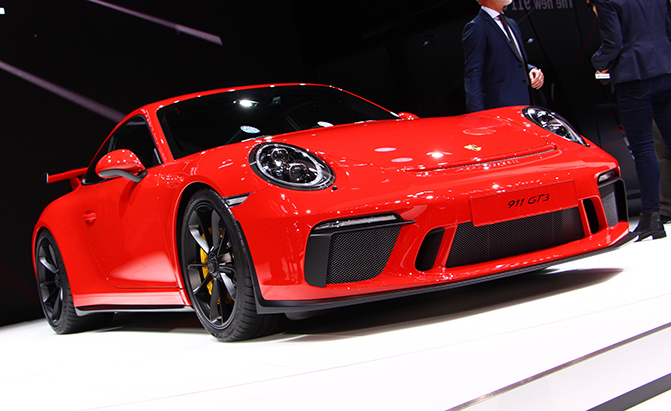Trying to one-up each other must be a favorite past time of automakers, especially when it comes to Nurburgring lap times.
Although it was once considered the holy grail of performance specs, Porsche seems to be stepping back from setting record Nurburgring lap times for one simple reason: it’s just not that fun.
During an interview with after the North American debut of the 2018 Porsche 911 GT3, which is now available with a manual transmission option, Porsche GT boss Andreas Preuninger shed some light on why they brought back the manual.
“There are a lot of people who aren’t looking at the stopwatch when they’re on the track and they just want the interaction and they want a driver’s car,” he said at the New York Auto Show, saying that making the GT3 more fun was the main goal. “This is the reason why we left the route of being the quickest on the Nurburgring and only thinking about lap times. I don’t care that the competition is a little bit faster around the ‘Ring.”
ALSO SEE: Porsche GT Boss Wants You to Stop Babying Your 911 R
Simply put, he said, lap times are great and all, but drivability is king.
“It’s not our mainstream program to have the quickest lap times and to advertise our cars only by lap time because, to be honest with you, if you have a car with the perfect setup for the Nurburgring, it will be a dog on the street and everywhere else.”
Preuninger is very aware that the manual isn’t as fast as the PDK, but the demand for a manual GT3 wasn’t coming from the people who wanted more speed – it was coming from drivers who wanted more engagement.
“This is about a rewarding driving sensation, the smile, the feeling that you want to pat the car on the roof when you get out. That’s very important,” he said. “You can have a car that theoretically you know can go fast, but maybe it feels so perfect that it gets boring.”
With the previous GT3, which only came with a PDK automatic, the focus was on Porsche’s race program, so lap times were the top priority.
“I like old-school stuff in cars, and that includes mechanics as well,” Preuninger said. “But I recognize that for performance reasons, there is some modern technology that needs to be in a GT car to stay in pole position.”
In the past, weight reduction was prioritized as a way to enhance a race car’s performance, and as manual gearboxes are generally lighter than automatics it only made sense for race cars to have manuals. Back then, two generations ago, the GT3 was exclusively offered with a manual. As technology caught up, however, Porsche needed more than weight reduction, so it opted for the faster shifting automatic. Porsche dropped the manual from the previous GT3 because it simply didn’t have the capacity to research and develop two transmissions. But the people have spoken and Porsche is happy to once again offer two different transmission options for the GT3.
“We see that the more digitalized the world gets on the one side, the more there’s this lust for old-school, mechanical driver’s cars,” Preuninger said. “With the choice of two gearboxes, we can satisfy both customers.”
Preuninger says he has bets with his colleagues that the take rate for the manual GT3 will be about 30 percent. He also hinted that lap times haven’t fallen off the radar completely for Porsche.
“We will strike back because the Empire always strikes back,” he said, quoting . “We have some aces up our sleeve because we’re competitive as well.”



Leave a Reply